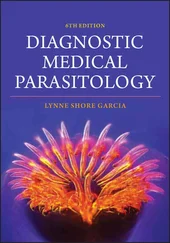Alan Gunn - Parasitology
Здесь есть возможность читать онлайн «Alan Gunn - Parasitology» — ознакомительный отрывок электронной книги совершенно бесплатно, а после прочтения отрывка купить полную версию. В некоторых случаях можно слушать аудио, скачать через торрент в формате fb2 и присутствует краткое содержание. Жанр: unrecognised, на английском языке. Описание произведения, (предисловие) а так же отзывы посетителей доступны на портале библиотеки ЛибКат.
- Название:Parasitology
- Автор:
- Жанр:
- Год:неизвестен
- ISBN:нет данных
- Рейтинг книги:3 / 5. Голосов: 1
-
Избранное:Добавить в избранное
- Отзывы:
-
Ваша оценка:
- 60
- 1
- 2
- 3
- 4
- 5
Parasitology: краткое содержание, описание и аннотация
Предлагаем к чтению аннотацию, описание, краткое содержание или предисловие (зависит от того, что написал сам автор книги «Parasitology»). Если вы не нашли необходимую информацию о книге — напишите в комментариях, мы постараемся отыскать её.
Highly detailed textbook on parasites and parasite relationships Parasitology: An Integrated Approach
Parasitology: An Integrated Approach, 2nd edition
Parasitology — читать онлайн ознакомительный отрывок
Ниже представлен текст книги, разбитый по страницам. Система сохранения места последней прочитанной страницы, позволяет с удобством читать онлайн бесплатно книгу «Parasitology», без необходимости каждый раз заново искать на чём Вы остановились. Поставьте закладку, и сможете в любой момент перейти на страницу, на которой закончили чтение.
Интервал:
Закладка:
An obligate parasite is one that has no alternative but to develop as a parasite of its host. On the other hand, a facultative parasite can develop as a parasite or a free‐living organism depending upon the circumstances. For example, the larvae of the warble fly Hypoderma bovis must develop as parasites of cattle and are therefore obligate parasites. By contrast, the larvae of the blowfly Lucilia sericata are facultative parasites. This is because if the female fly lays her eggs upon a live sheep, the larvae will feed on living tissue and therefore be parasites. Conversely, if she lays her eggs on a dead sheep, the larvae will feed as free‐living detritivores. Similarly, the amoeba Naegleria fowleri can live as a free‐living organism in ponds and lakes but if it enters the nostrils of someone swimming in the water, then it can become an opportunistic parasite and infect their brain.
As mentioned above, some organisms, such as the human body louse Pediculus humanus , are parasitic at all stages of their life cycle, whilst others are only parasitic at one or more stages. For example, the blood fluke Schistosoma haematobium parasitises us during its adult stage and snails during two of its larval stages but it also has two non‐feeding free‐living stages. The act of being a parasite is therefore stage specific. Some estimates suggest that as many as 50% of all known species are parasites at some point in their life cycle. However, this estimate is subject to the caveat that there is no consensus about what constitutes a species, especially among the prokaryotes. The number of known species is also a reflection of the interests of biologists in different groups of animals. For example, the fact that insects account for 72% of all known species is, at least partly, a consequence of them being studied intensively for over 200 years. In one insect order alone, the Hymenoptera (ants, bees, wasps), there are approximately 100,000 parasitoid species. By contrast, fewer people have studied mites and nematodes and the diversity of their parasitic species is probably vastly underestimated. Nevertheless, parasitism is a remarkably common lifestyle and parasites (and their hosts) exist in all the major groups of living organisms including the archaea, bacteria, fungi, plantae, protozoa, invertebrates, and vertebrates.
There is an endless debate as to whether viruses are parasitic organisms. At one level, this would appear to be self‐evident since viruses are incapable of maintaining themselves or reproducing except when within their host cell. However, being composed of complex organic molecules and having the capacity to evolve is not necessarily synonymous with being a living entity, especially when those attributes are dependent upon existing within a host cell. We will discuss this topic further in Section 2.2.
1.2.5.1 Intra‐specific Parasites
Although most parasitic relationships involve two different species, intra‐specific parasitism also occurs. Brood parasitism is a common example of intra‐specific parasitism among many birds (Tomás et al. 2017) and some social wasps (Oliveira et al. 2016). It involves a female laying her eggs in the nest of a conspecific (member of the same species) – this means that the costs of rearing, the young will be borne by another individual. Intra‐specific parasitism sometimes occurs during sexual reproduction when the male attaches to the female and becomes dependent upon her for the provision of nutrients. For example, in certain deep‐sea angler fish belonging to the suborder Ceratioidea, the larval fish develop in the upper 30 m of sea water and then gradually descend to deeper regions as they metamorphose into adults. The adolescent males have a very different morphology to the females: they are much smaller; they have larger eyes, and, in some species, they develop a large nasal organ that presumably helps in their search for females. Furthermore, the males cease feeding and rely upon reserves laid down in their liver during the larval period to fuel their swimming. Upon finding a suitable female, the male grasps onto her using special tooth‐like bones that develop at the tips of his jaws (his actual teeth degenerate during metamorphosis). After attaching, the male grows (although he remains much smaller than his consort), and his testes mature. His skin and blood vessels fuse with hers at the site of attachment, and he remains attached for the rest of his life and draws all his nourishment from her. Some authors suggest that the male must find a virgin female. However, although most females carry only a single male, there are records of females with three or more males attached to them. This is presumably an adaptation to life in the deep‐sea regions in which the opportunity to locate mates is limited. Nevertheless, this raises questions about how sexual selection occurs because it is unusual in nature for a female to mate with just one male for life, especially if that male is the first one to turn up. This type of relationship is not found in all ceratioid anglerfish; in some species, the males are facultative parasites rather than obligate ones as described in the above scenario, whilst in other species the males are free‐living, capable of capturing their own food, and form only temporary attachments to females. Molecular evidence suggests that the development of the parasitic males is a relatively plastic phenomenon among anglerfish and has evolved and subsequently become lost on several occasions (Pietsch 2005).
1.2.6 Parasitoids
The term parasitoid is restricted to certain parasitic insects whose hosts are almost exclusively other insects – although a few species attack certain crustacea, spiders, millipedes, centipedes, and earthworms. Some parasites cause mortality and may even depend on the death of their host to effect transmission to the next stage of their life cycle, but host death is not inevitable. By contrast, parasitoids slowly consume their host’s tissues so that the host remains alive until the parasitoid has completed its development. At this point, the host dies either through the loss of vital tissues or through the parasitoid physically eating its way out of its host. Parasitoids are all parasitic during their larval stage, and the adult insect is free living and feeds on nectar, pollen, dead organic matter, or is predatory, depending upon the species. Parasitoids can develop as endoparasites within their host or as ectoparasites attached to the outside but with their mouthparts buried deep within the host’s body. The larva has only the one host in or on which it develops and those that are endoparasites tend to exhibit the most host specificity. This lifestyle is therefore distinct from those insects such as warble flies (e.g., Hypoderma bovis ) and bot flies (e.g., Gasterophilus intestinalis ), which exhibit a more ‘traditional’ parasitic way of life that does not inevitably result in the death of the host. Many species of the order Hymenoptera (bees, ants, wasps) are parasitoids, and it is also a common lifestyle among the Diptera (true flies), but it is absent or very rare among the other orders. By contrast, most of the insect orders are hosts to parasitoids. Hyperparasitism is also common in which a parasitoid parasitizes another species of parasitoid. Parasitoids are effective for the control of agricultural pests, particularly within closed environments such as greenhouses. However, they have had limited success as control agents for parasites, their vectors, or intermediate hosts.
The parasitoid lifecycle typically begins with the adult female locating its host and either injecting one or more eggs or attaching them to the host’s outer surface. Sometimes she also injects a toxin that temporarily or permanently disables her victim. The host is chosen based on its stage of development, which may be anywhere from the egg to the adult stage.
Читать дальшеИнтервал:
Закладка:
Похожие книги на «Parasitology»
Представляем Вашему вниманию похожие книги на «Parasitology» списком для выбора. Мы отобрали схожую по названию и смыслу литературу в надежде предоставить читателям больше вариантов отыскать новые, интересные, ещё непрочитанные произведения.
Обсуждение, отзывы о книге «Parasitology» и просто собственные мнения читателей. Оставьте ваши комментарии, напишите, что Вы думаете о произведении, его смысле или главных героях. Укажите что конкретно понравилось, а что нет, и почему Вы так считаете.












